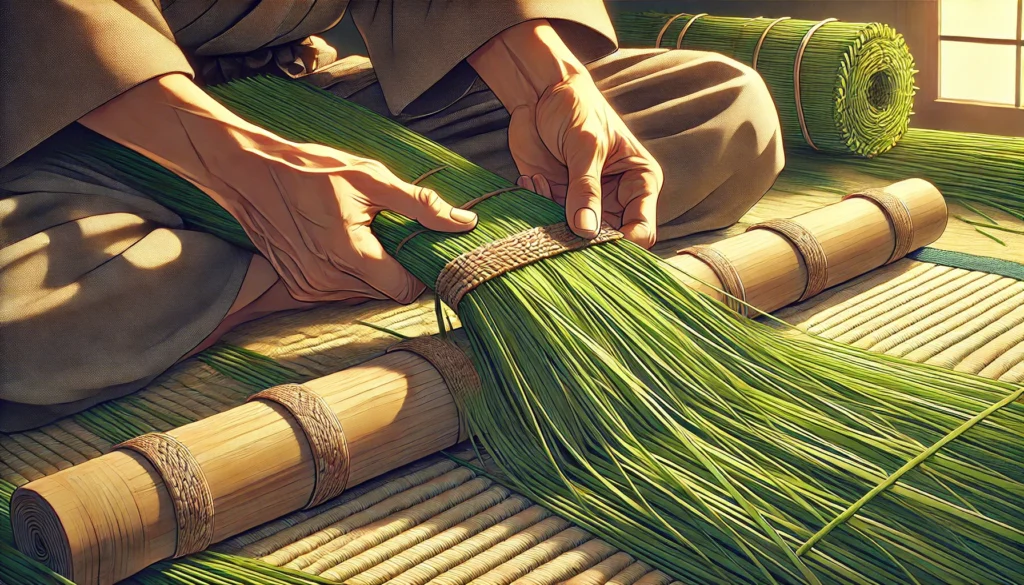Have you ever stepped into a traditional Japanese room and felt the unique texture beneath your feet? That distinctive flooring is tatami, a cornerstone of Japanese interior design with centuries of cultural significance. In this comprehensive guide, we’ll explore everything you need to know about Japanese tatami mats – from their fascinating history to practical care tips for modern homes.
The Essence of Japanese Tatami: More Than Just Flooring
When asking “what are Japanese tatami,” you’re inquiring about more than simple floor covering. Tatami (畳) are traditional Japanese floor mats made from woven rush grass (igusa) over a core material. These rectangular mats create a distinctive look, feel, and even scent that instantly transforms any space into a traditional Japanese environment.
Traditional tatami mats feature:
- A soft, slightly springy surface
- Natural green coloring that yellows with age
- A pleasant, grassy aroma when new
- Fabric borders (heri) for a clean, finished appearance
Tatami represents the perfect blend of practicality and cultural significance. As one visitor to Japan commented, “Walking on tatami feels like being connected to centuries of Japanese tradition with every step.”
The Rich History of Tatami in Japanese Culture
Tatami’s story begins over 1,200 years ago during the Nara period (710-794 CE). Originally, these mats served as luxury items for nobility, used primarily for sleeping or sitting rather than as permanent flooring.
From Elite Luxury to Household Standard
Initially, tatami mats were status symbols exclusive to Japan’s aristocracy and samurai class. By the Muromachi period (1336-1573), tatami began covering entire rooms in elite residences. The Edo period (1603-1868) saw tatami’s popularity spread throughout all social classes, becoming a standard feature in Japanese housing.
This democratization of tatami reflects broader cultural shifts in Japanese society. As architectural historian Kazuo Nishi notes, “The evolution of tatami usage mirrors Japan’s social transformation, from rigid class distinctions to more widespread access to traditional aesthetics.”
Tatami in Traditional Japanese Architecture
The integration of tatami into Japanese homes fundamentally shaped architectural design. Room sizes became standardized based on tatami mat dimensions, creating the jo (畳) measurement system still used today.
What Are Japanese Tatami Made From?
Understanding tatami materials helps explain their unique properties and care requirements.
Traditional Construction
Authentic tatami consists of three main components:
- Core (doko): Traditionally made from compressed rice straw, though modern versions may use wood chipboard or polystyrene foam for durability and lower cost
- Surface covering: Woven rush grass (igusa) meticulously hand-stitched over the core
- Border (heri): Decorative fabric edges, typically made from cotton or synthetic materials
The rush grass surface creates tatami’s distinctive texture and releases a natural fragrance reminiscent of freshly cut hay when new.
Regional Variations
Like many Japanese traditions, tatami dimensions vary by region:
- Kyoto size: Approximately 0.95 × 1.91 meters, traditionally used in imperial palaces
- Tokyo size: Roughly 0.88 × 1.76 meters, common in eastern Japan
- Nagoya size: About 0.91 × 1.82 meters, found in central Japan
Most tatami mats are 5-6 centimeters thick, providing cushioning while remaining firm enough for daily use.
The Jo System: How Tatami Defines Japanese Spaces
One fascinating aspect of Japanese architecture is how tatami became the standard unit for measuring room sizes. Instead of square meters or feet, Japanese real estate still often describes rooms by their tatami capacity.
Understanding Jo Measurements
The term “jo” (畳) refers to the number of standard tatami mats that would fit in a room. For example:
- A 4.5 jo room accommodates 4.5 tatami mats
- A 6 jo room fits 6 full-sized tatami mats
- An 8 jo room accommodates 8 tatami mats
This measurement system persists even in modern Japanese apartments with Western-style flooring, demonstrating tatami’s enduring influence on spatial concepts in Japan.
Traditional Tatami Arrangements
Tatami mats follow specific arrangement patterns to create aesthetically pleasing and structurally sound floors:
- The “four-and-a-half mat” arrangement (yonjo-han) creates an intimate tea ceremony space
- The “eight mat” layout (hachijo) forms a standard living room
- The “six mat” configuration (rokujo) makes a typical bedroom size
The rule governing arrangements is that mats should never form a cross pattern where four corners meet at a single point, as this is considered unlucky.
If you’re learning Japanese and want to understand the language behind these concepts, our free “Counting to 100 in Japanese” guide will help you master the numerical terms used in tatami measurements.
Tatami in Contemporary Japanese Life
While fully tatami-floored homes have declined in modern Japan, tatami remains an important element in contemporary Japanese living.
The Washitsu: Japanese-Style Room
Many modern Japanese homes feature at least one washitsu (和室) or Japanese-style room with tatami flooring. This creates a multifunctional space that can serve as:
- A guest room with futon bedding
- A meditation or relaxation area
- A traditional dining space for special occasions
- A room for practicing Japanese arts like tea ceremony
The washitsu exemplifies the Japanese concept of harmonizing traditional elements with modern convenience.
Tatami in Hospitality and Tourism
For visitors to Japan, experiencing tatami is often a highlight. Traditional ryokan inns, tea houses, and many restaurants maintain tatami rooms, providing an authentic cultural experience.
As noted in my article on climate and seasons in Japan, tatami rooms feel especially comfortable during hot, humid summers thanks to the natural cooling properties of rush grass.
Tatami in Japanese Martial Arts
Beyond residential use, tatami holds special significance in Japanese martial arts traditions.
From Floor Mats to Training Surface
Traditional martial arts like judo, aikido, and some karate styles use specialized tatami mats for training surfaces. These mats provide:
- Sufficient firmness for stable footing
- Appropriate cushioning for falls and throws
- A traditional aesthetic that connects practice to cultural heritage
In martial arts contexts, stepping onto the tatami signifies entering a sacred training space where students should demonstrate proper etiquette and focus.
Modern Adaptations
Contemporary martial arts tatami differ from residential versions, featuring:
- Denser foam cores for increased shock absorption
- More durable coverings to withstand intense training
- Standardized dimensions for competition areas
Despite these adaptations, these training surfaces are still referred to as tatami and maintain the cultural respect associated with traditional mats.
Caring for Tatami: Maintenance Tips
What are Japanese tatami requirements for proper care? Understanding tatami maintenance is essential for preserving these traditional mats.
Daily Care Practices
Proper tatami maintenance includes:
- Regular cleaning: Vacuum with a tatami-specific attachment or gently wipe with a dry cloth
- Directional cleaning: Always clean in the direction of the rush grass, never against the grain
- Sunlight exposure: Occasionally allow sunlight to reach tatami to prevent mold growth
- Air circulation: Ensure adequate ventilation in tatami rooms
Protecting Your Tatami Investment
To extend tatami lifespan:
- Never wear shoes on tatami
- Use appropriate furniture with wide, flat legs that distribute weight evenly
- Avoid placing heavy objects directly on tatami
- Clean spills immediately to prevent staining
- Rotate mats periodically for even wear
With proper care, quality tatami can last 5-6 years before requiring replacement.
If you’re learning Japanese vocabulary related to home and cleaning, our “100+ Essential Japanese Phrases” guide includes useful terms for discussing household maintenance.
Installing Tatami in Your Home
Interested in bringing tatami into your own space? Modern options make this increasingly accessible outside Japan.
Full Tatami Room Installation
Creating a complete washitsu involves:
- Preparing a clean, level subfloor
- Installing tatami mats in traditional patterns
- Considering complementary elements like shoji screens and low furniture
For authentic results, consult with specialists in Japanese interior design who understand proper installation techniques.
Modern Tatami Alternatives
Don’t have space for a full tatami room? Consider:
- Tatami tiles: Smaller sections that can be installed over existing flooring
- Tatami beds: Platform beds with tatami mat surfaces
- Tatami chair pads: Small mats designed for sitting areas
- Roll-up tatami mats: Portable options for temporary use
These alternatives provide tatami’s aesthetic and sensory benefits without requiring structural modifications.
The Cultural Significance of Tatami
Beyond practical considerations, understanding what Japanese tatami represent culturally enriches appreciation for these traditional mats.
Tatami in Japanese Aesthetics
Tatami embodies core principles of Japanese design:
- Wabi-sabi: The beauty of natural imperfection and aging
- Simplicity: Clean lines and uncluttered spaces
- Natural materials: Connection to the environment
- Functionality: Practical design with multiple uses
These aesthetic principles continue to influence global design trends, making tatami relevant to contemporary minimalist and eco-friendly approaches.
Tatami Etiquette
Traditional tatami rooms observe specific customs:
- Removing shoes before entering
- Avoiding stepping on the decorative borders between mats
- Not walking heavily or dragging objects across the surface
- Sitting or kneeling rather than standing when possible
Understanding these practices demonstrates respect for Japanese cultural traditions.
For those learning Japanese writing related to home and traditions, our “Hiragana & Katakana Cheat Sheet” and “JLPT N5 Kanji Cheat Sheet” include essential characters for discussing traditional Japanese homes.
Frequently Asked Questions About Tatami
How long do tatami mats last?
With proper care, quality tatami mats typically last 5-6 years before requiring replacement or flipping. Factors affecting lifespan include usage levels, maintenance practices, and climate conditions.
Can tatami be used with underfloor heating?
Modern tatami can work with underfloor heating systems, though traditional mats may dry out excessively. Consult with tatami specialists about compatible products designed for heated floors.
Are tatami mats suitable for allergy sufferers?
While natural materials like rush grass might concern allergy sufferers, properly maintained tatami actually resist dust mites better than carpeting. Regular cleaning and adequate ventilation minimize potential allergen issues.
Where can I purchase authentic tatami outside Japan?
Specialized Japanese furniture retailers, online importers, and some home improvement stores now offer tatami internationally. Look for products with certification from Japanese manufacturers to ensure authenticity.
Embracing Tatami in Modern Living
As we’ve explored in detail, Japanese tatami represents far more than flooring—it embodies centuries of cultural tradition, practical design, and aesthetic sensibility. Whether you’re planning a trip to Japan, considering tatami for your own home, or simply appreciating Japanese design principles, understanding tatami enriches your connection to this enduring element of Japanese culture.
The next time someone asks “what are Japanese tatami,” you can share not just the physical description but also the rich historical and cultural significance these remarkable mats continue to hold in both traditional and contemporary contexts.
For more insights into Japanese culture and language, browse our complete collection of free Japanese learning guides, including pronunciation tips, vocabulary lists, and writing practice sheets to enhance your understanding of this fascinating culture.
Have you experienced tatami in Japan or incorporated these traditional mats into your own home? We’d love to hear your stories and insights in the comments below!




